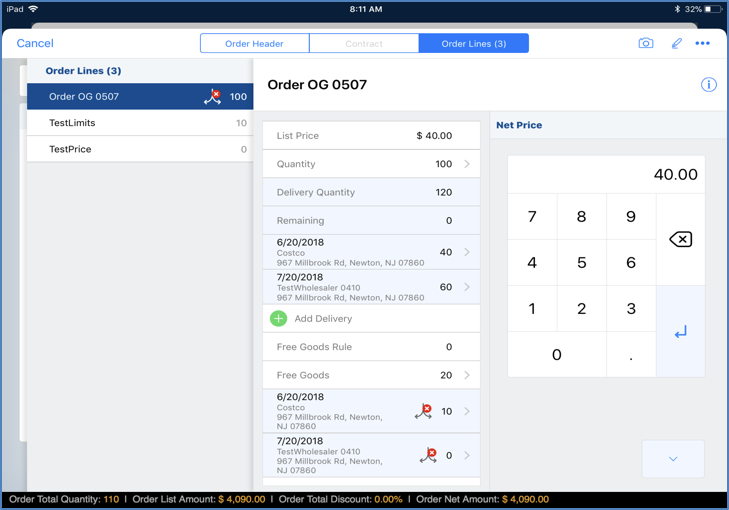Manual Allocation of Free Goods
- Browser
- CRM Desktop (Windows)
- iPad
Veeva CRM now supports the manual allocation of Free Goods in Line Delivery Splitting. Users can customize the quantities of Free Goods to reflect the appropriate ratio of Free Goods to paid goods on the delivery invoice. This provides companies an easier way to manage Line Delivery Splitting and discount regulations.
For example, Sarah Jones creates an order with Line Delivery Splitting and gets 60 Cholecap Free Goods. She manually sets 10 Cholecap Free Goods to be delivered each month for the next 6 months. Her customer receives an invoice detailing the delivery, the paid goods, Free Goods, and the ratio between the two.
Configuring Manual Allocation of Free Goods
Prerequisites
Ensure initial configuration is complete before enabling this functionality.
To enable manual allocation of free goods:
- Ensure Line Delivery Splitting is enabled.
- Ensure the Number Delivery Dates and OM Delivery Split Mode Veeva Settings are enabled.
- Grant users FLS read permission to the Zvod_Delivery_Date_vod field on the Order_vod object.
- Place the zvod_Free_Good_Splitting_vod field on the appropriate page layout.
- Place the zvod_Delivery_Date_vod field on the appropriate page layout.
- Place the Free_Goods_vod and Free_Goods_Rule_vod fields on the appropriate page layout to display the Manual Allocator.
Manual Allocation is not available when OM Delivery Split Mode is set to 3 or when using classic delivery date splitting.
Using Manual Allocation of Free Goods
Users select the Free Good quantities and manually determine the delivery location and quantity of Free Goods. After the user submits the order, the customer receives an invoice reflecting the quantity of Free Good to Paid Good per split delivery.

Order Line Splitting Behavior
Free Goods
- If Manual Delivery Splitting is not enabled, free goods are allocated to the first delivery and display in parenthesis. They are counted in the Delivery_Quantity_vod field, but not in the Quantity_vod field.
- If the remaining value is not = 0, a warning displays
- Cross-Product Rebates — if a free goods cross-product rebate occurs, the free goods are allocated to the first delivery
Kits
- Only the Kit line is available for splitting
- Kit component lines are created in the delivery Orders
- If a Kit item is deleted from one delivery, the Kit component lines are deleted in that order
Mass-Add Products
- If multiple splits are created on the header, all auto-added Order Lines contain the split information. The delivery Quantity is zero.
- If there are no splits, the auto-added Order Lines display without the splitting and the Add Delivery button
With the appropriate CRUD permissions on the master Order:
- If the master Order is submitted, all delivery orders are submitted
- If the master Order is void, all delivery orders are void
- If the master Order is unlocked, all delivery orders are unlocked
- If the master Order is deleted, all delivery orders are deleted
When saving an Order with line split deliveries, each delivery line is saved as a separate delivery order. The master Order is saved and child delivery orders are created. If there is a discrepancy between the Quantity and the Delivery Quantity for at least one product, an error message displays.
If there is only one delivery line, entering a delivery quantity does not automatically roll-up into the master quantity.
Users can clone the master Order but cannot clone the split delivery information or create split delivery orders.
All manual edits to individual deliveries must be done via the master Order on the iPad to maintain delivery order synchronization.
Users can determine how individual split quantities are allocated using the OM_DISABLE_QUANTITY_SPLIT_ROLLUP_vod Veeva Setting. When the OM_DISABLE_QUANTITY_SPLIT_ROLLUP_vod setting is enabled with a value of 1, the individual delivery quantities in an order is allocated in the master quantity. When disabled, the individual delivery quantities are reflected in the Remaining Quantities field.



